Comparing the Costs and Revenues of Transformation to Continuous Cover Forestry for Sitka Spruce in Great Britain
Abstract
:1. Introduction
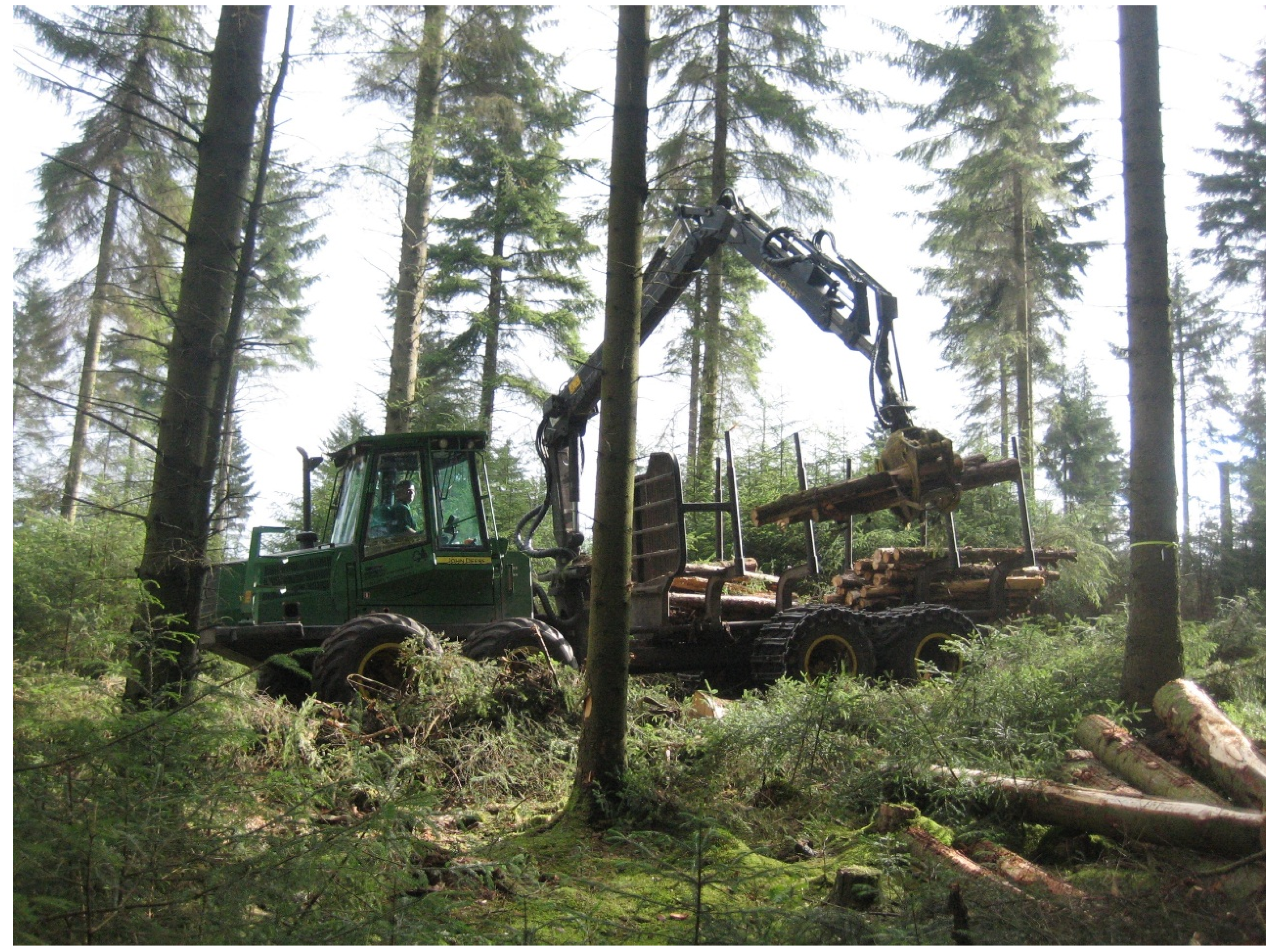
2. Material and Methods
2.1. Scenarios
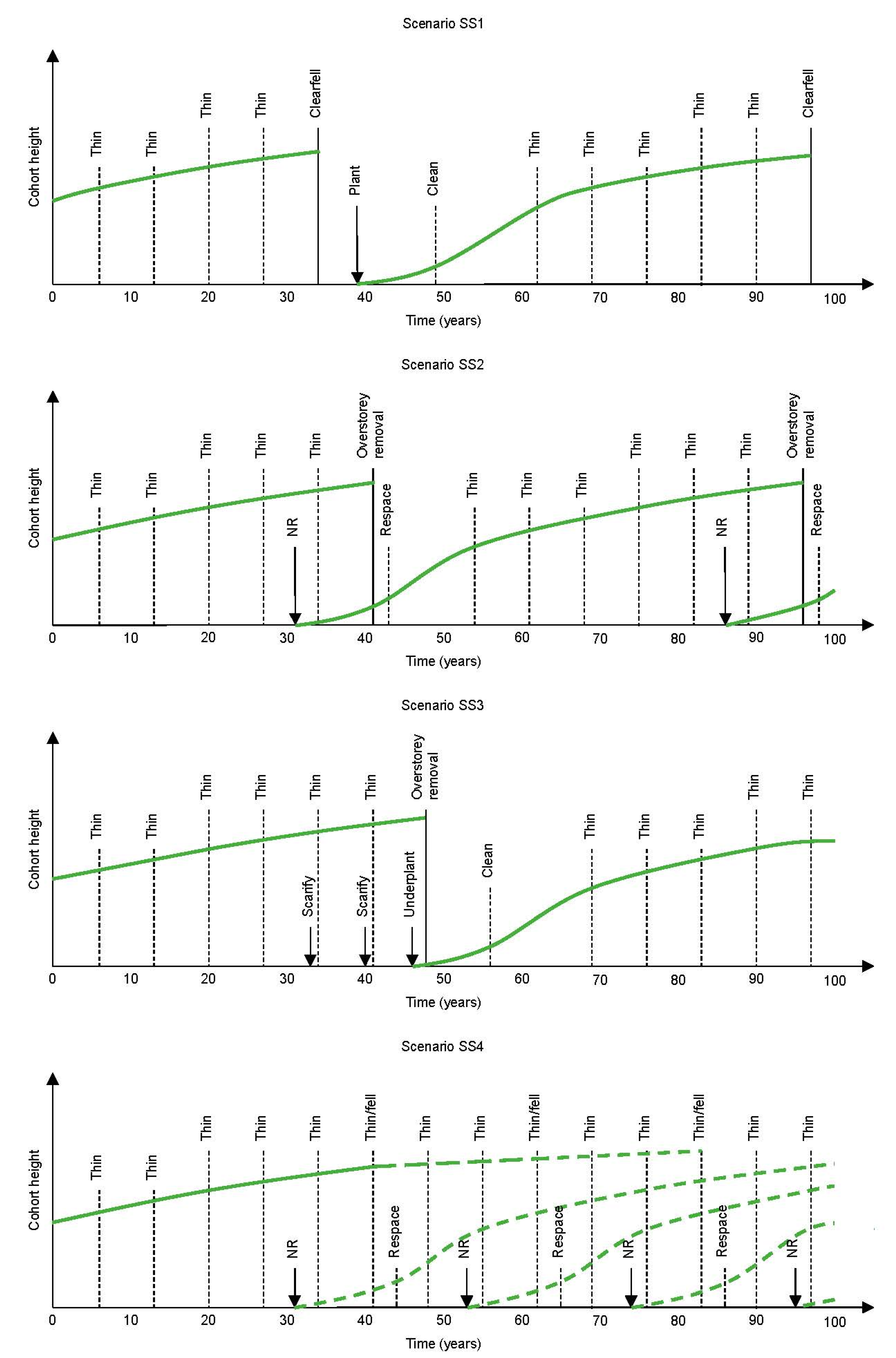
2.1.1. Scenario SS1—Clearfell and Replant
2.1.2. Scenario SS2—Transformation to a Simple Structure Using Natural Regeneration
2.1.3. Scenario SS3—Transformation to a Simple Structure Using Underplanting
2.1.4. Scenario SS4—Transformation to a Complex Structure
2.2. Growth and Yield Modelling

2.3. Costs
2.4. Revenues
2.5. Financial Comparisons
| Time Period (years) | Discount Rate (%) |
|---|---|
| 0–30 | 3.5 |
| 31–75 | 3.0 |
| 76–125 | 2.5 |
| 126–200 | 2.0 |
| 201–300 | 1.5 |
| 301+ | 1.0 |
2.6. Sensitivity Analysis
- Management overhead costs—in addition to the baseline cost of £29.75 per hectare per year, a reduced overhead of £15 and an increased figure of £45 were used. Note that these changes in the absolute management overhead cost do not alter the relative costs, which remain at 150% for scenarios SS2 and SS3 and at 200% for scenario SS4.
- Relative management overhead costs for the four scenarios—in addition to the baseline of 100%/150%/150%/200% for the four scenarios, comparisons were made with no differentiation in cost between scenarios (100% for all four regimes) and with a greater differentiation in cost (100% for SS1, 200% for SS2 and SS3, and 400% for SS4).
- Product prices—in addition to the baseline, one option assumed a higher value for chipwood/pulpwood of £20 m−3 (in a British context representing potentially increased demand for biofuel) and another option assumed an enhanced value of £40 m−3 for sawlogs.
- Discount rate—the following rates were investigated: 1.0% constant, 3.5% declining (the baseline rate), 3.5% constant, 6.0% declining, and 6.0% constant.
3. Results
3.1. Net Present Values Using Baseline Assumptions
| Scenario | Net Present Value per Hectare Considering Cash Flows… | ||
|---|---|---|---|
| to 20 years | to 100 years | in perpetuity | |
| SS1 | −£724 (−100.0%) a | £2,875 (100.0%) | £2,852 (100.0%) |
| SS2 | −£600 (−82.9%) | £2,822 (98.1%) | £3,027 (106.1%) |
| SS3 | −£600 (−82.9%) | £1,398 (48.6%) | £1,706 (59.8%) |
| SS4 | −£651 (−89.9%) | £988 (34.3%) | £1,568 (55.0%) |
3.2. Volume Outturn Using Baseline Assumptions
| Scenario | Mean Annual Volume Outturn (m3 per ha per year) | |||
|---|---|---|---|---|
| Sawlogs | Bars | Chip/pulp | Total | |
| SS1 | 2.8 (27.3%) | 3.3 (32.3%) | 4.2 (40.3%) | 10.3 |
| SS2 | 4.0 (31.1%) | 4.0 (30.6%) | 5.0 (38.3%) | 13.0 |
| SS3 | 4.0 (31.1%) | 4.0 (30.6%) | 5.0 (38.3%) | 13.0 |
| SS4 | 4.8 (35.3%) | 4.2 (31.0%) | 4.6 (33.8%) | 13.7 |
| Scenario | Mean Annual Volume Outturn (m3 per ha per year) | |||
|---|---|---|---|---|
| Sawlogs | Bars | Chip/pulp | Total | |
| SS1 | 11.1 (70.5%) | 2.3 (14.4%) | 2.4 (15.0%) | 15.7 |
| SS2 | 11.8 (71.3%) | 2.2 (13.3%) | 2.5 (15.3%) | 16.6 |
| SS3 | 8.0 (64.1%) | 2.0 (16.3%) | 2.4 (19.7%) | 12.4 |
| SS4 | 9.2 (71.9%) | 1.6 (12.4%) | 2.0 (15.8%) | 12.9 |
3.3. Sensitivity Analysis
3.3.1. Management Overheads
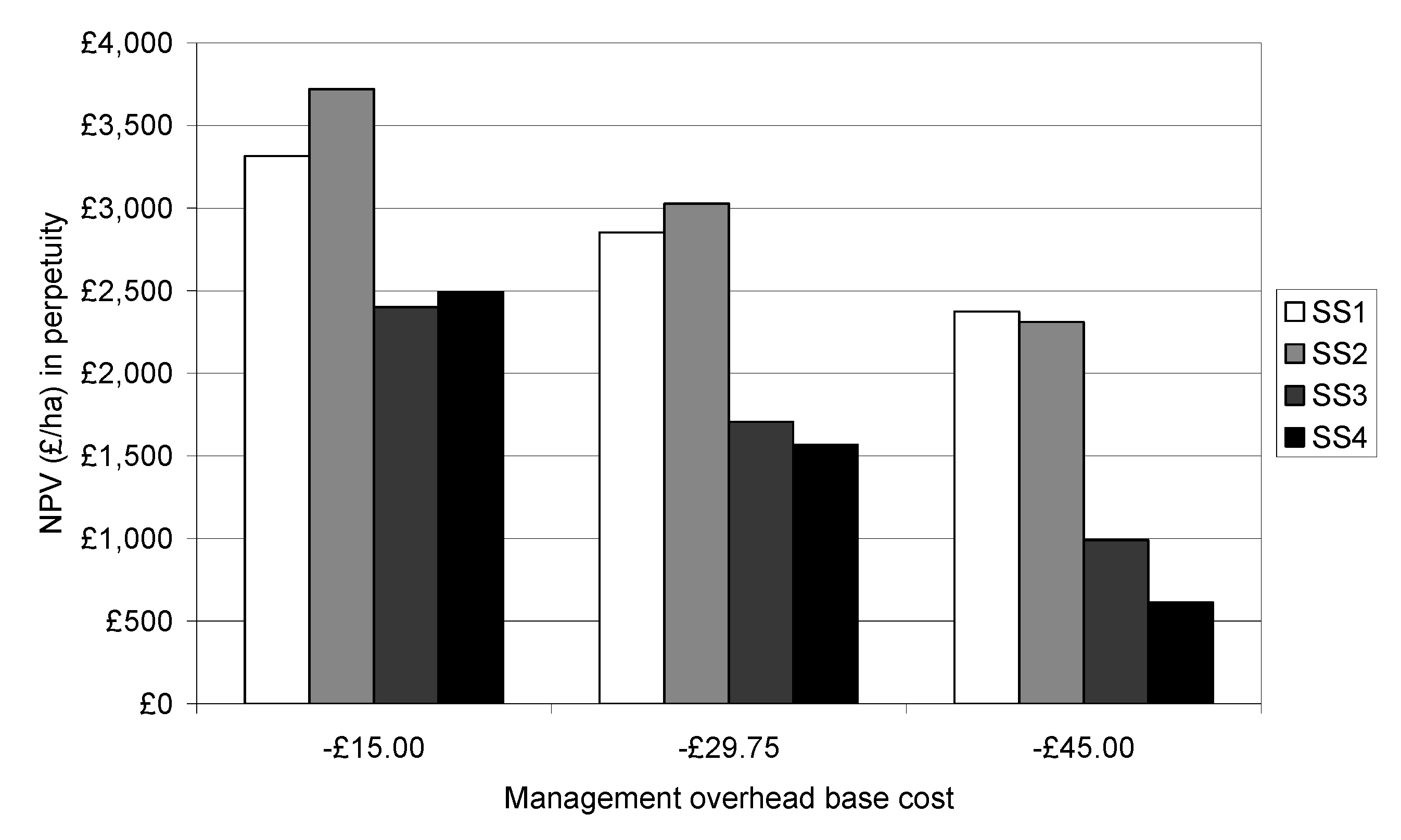
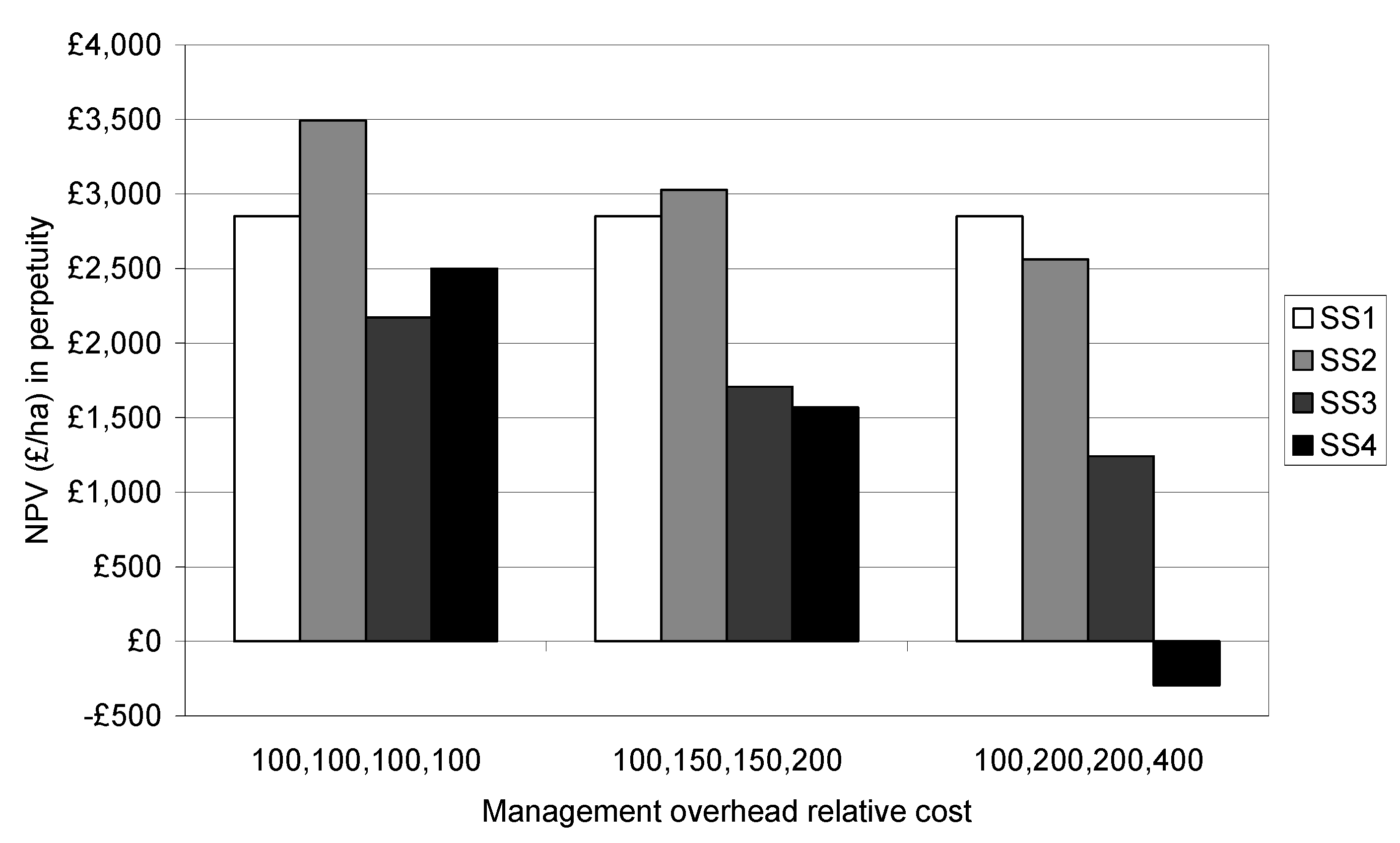
3.3.2. Product Prices
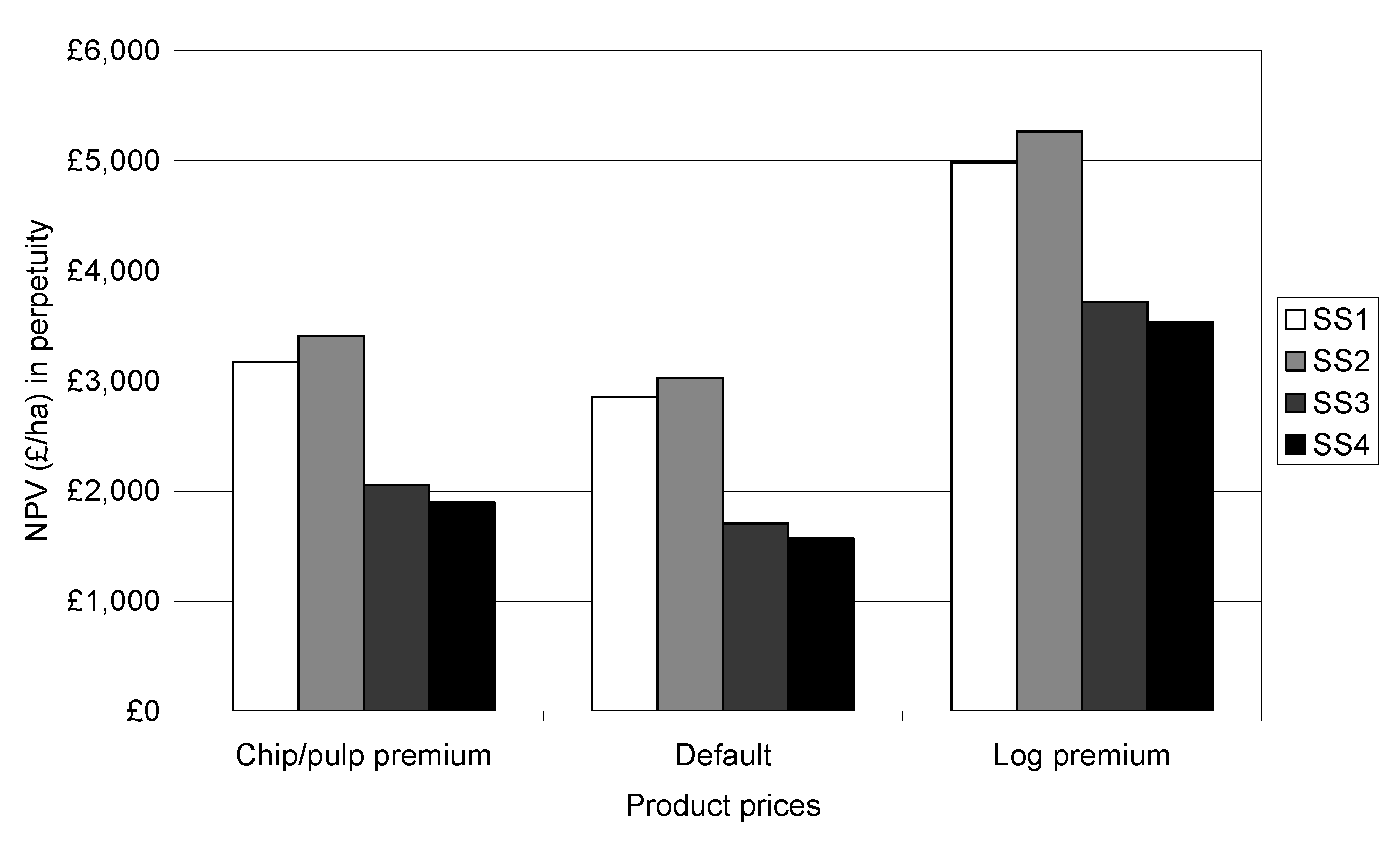
3.3.3. Discount Rate

4. Discussion
4.1. Scope of the Study and Issues Not Addressed
4.1.1. Genetic Changes
4.1.2. Timber Quality, Products and Changing Prices
4.1.3. Risk and Stochastic Events
4.2. Comparison of Scenarios
4.3. Sensitivity Analysis
4.4. Advantages and Disadvantages of the Study Approach
4.5. Applications of the Study Approach
4.6. Further Developments of the Approach
5. Conclusions
Supplementary Materials
Acknowledgments
Author Contributions
Conflicts of Interest
References
- Forestry Commission. Forestry Facts and Figures 2013; Forestry Commission: Edinburgh, Scotland, 2013.
- Miller, K.F. Windthrow Hazard Classification. In Forestry Commission Leaflet No. 85; HMSO: London, England, 1985. [Google Scholar]
- Troup, R.S. Dauerwald. Forestry 1927, 1, 78–81. [Google Scholar]
- Forestry Commission. The UK Forestry Standard, 3rd ed.Forestry Commission: Edinburgh, Scotland, 2011.
- UKWAS. United Kingdom Woodland Assurance Standard (UKWAS), 3rd ed.; Version 3.1; UKWAS: Edinburgh, Scotland, 2012. [Google Scholar]
- Mason, B.; Kerr, G. Transforming even-aged conifer stands to continuous cover management. In Forestry Commission Information Note No. 40. (Revised); Forestry Commission: Edinburgh, Scotland, 2004. [Google Scholar]
- Mason, B.; Kerr, G.; Simpson, J. What is continuous cover forestry? In Forestry Commission Information Note No. 29; Forestry Commission: Edinburgh, Scotland, 1999. [Google Scholar]
- Kerr, G. Managing Continuous Cover Forests. In Operational Guidance Booklet No. 7.; Version 3.0; Forestry Commission: Edinburgh, Scotland, 2008. [Google Scholar]
- Davies, O.; Kerr, G. The Costs and Revenues of Transformation to Continuous Cover Forestry; Version 2; Forest Research: Farnham, England, 2014.
- Edwards, P.N.; Christie, J.M. Yield models for forest management. In Forestry Commission Booklet No. 48; Forestry Commission: Edinburgh, Scotland, 1981. [Google Scholar]
- Forestry Commission. Plant density: Right first time. In Operational Guidance Booklet No. 4; Version 2.0; Forestry Commission: Edinburgh, Scotland, 2010. [Google Scholar]
- Rollinson, T.J.D. Thinning control. In Forestry Commission Booklet No. 54; HMSO: London, England, 1985. [Google Scholar]
- Moore, R. Managing the threat to restocking posed by the large pine weevil, Hylobius abietis. The importance of time of felling of spruce stands. In Forestry Commission Information Note No. 61; Forestry Commission: Edinburgh, Scotland, 2004. [Google Scholar]
- Matthews, J.D. Silvicultural Systems; Clarendon Press: Oxford, England, 1989. [Google Scholar]
- Hale, S. Managing light to enable natural regeneration in British conifer forests. In Forestry Commission Information Note No. 63; Forestry Commission: Edinburgh, Scotland, 2004. [Google Scholar]
- Matthews, J.D. Production of seed by forest trees in Britain. In Report on Forest Research for the Year Ending March, 1954; HMSO: London, England, 1955; pp. 64–78. [Google Scholar]
- Nixon, C.J.; Worrell, R. The potential for the natural regeneration of conifers in Britain. In Forestry Commission Bulletin No. 120; Forestry Commission: Edinburgh, Scotland, 1999. [Google Scholar]
- Stokes, V.; Kerr, G.; Ireland, D. Seedling height and the impact of harvesting operations on advance regeneration of conifer species in upland Britain. Forestry 2009, 82, 185–198. [Google Scholar] [CrossRef]
- Cameron, A.D.; Hands, M.O.R. Developing a sustainable irregular structure: An evaluation of three inventories at 6-year intervals in an irregular mixed-species stand in Scotland. Forestry 2010, 83, 469–475. [Google Scholar] [CrossRef]
- Price, M.; Price, C. Creaming the best, or creatively transforming? Might felling the biggest trees first be a win-win strategy? For. Ecol. Manag. 2006, 224, 297–303. [Google Scholar] [CrossRef]
- Jenkins, T.; Arcangeli, C.; Henshall, P.; Matthews, R. M1. Yield Model: Research Interface User Guide; Version 1.2.0.10; Forest Research: Farnham, England, 2012.
- Kerr, G.; Mason, B.; Boswell, R.; Pommerening, A. Monitoring the transformation of even-aged stands to continuous cover management. In Forestry Commission Information Note No. 45; Forestry Commission: Edinburgh, Scotland, 2002. [Google Scholar]
- Price, M.H. Aspects of the economics of transformation. Harvesting Productivity: A Case Study of Different Intervention Types in the Conversion of Welsh Sitka Spruce to Continuous Cover Forestry. Ph.D. Thesis, Bangor University, Bangor, UK, 2007. [Google Scholar]
- Ireland, D. Transformation thinning in CCF with advanced natural regeneration. Case study: Clocaenog, North Wales. In Internal Project Information Note No. 21/07; Technical Development; Forest Research: Alice Holt Lodge, Farnham, England, 2008. [Google Scholar]
- Ireland, D. CCF operational best practice: Final overstorey removal in uniform shelterwood. In Internal Project Information Note No. 45/08; Technical Development; Forest Research: Alice Holt Lodge, Farnham, England, 2009. [Google Scholar]
- Matthews, R.W.; Mackie, E.D. Forest Mensuration: A Handbook for Practitioners; Forestry Commission: Edinburgh, Scotland, 2006.
- Price, C. The Theory and Application of Forest Economics; Blackwell: Oxford, England, 1989. [Google Scholar]
- Welsh Assembly Government. Woodlands for Wales: The Welsh Assembly Government’s Strategy for Woodlands and Trees; Welsh Assembly Government: Cardiff, Wales, 2009.
- Halsall, L.; Gilbert, J.; Matthews, R.; Fairgrieve, M. New forecast of softwood availability in the UK. For. Br. Timber 2006, 35, 14–23. [Google Scholar]
- Treasury, H.M. The Green Book: Appraisal and Evaluation in Central Government; The Stationery Office: London, England, 2003. [Google Scholar]
- Krieger, D.J. The Economic Value of Forest Ecosystem Services: A Review; The Wilderness Society: Washington, USA, 2001. [Google Scholar]
- Price, C. The economics of transformation from even-aged to uneven-aged forestry. In Recent Accomplishments in Applied Forest Economics; Helles, F., Strange, N., Wichmann, L., Eds.; Kluwer: Amsterdam, The Netherlands, 2003. [Google Scholar]
- Rook, D.A. Super Sitka for the 90s. In Forestry Commission Bulletin No. 103; HMSO: London, England, 1992; p. 75. [Google Scholar]
- Price, C.; Price, M. Cost-benefit analysis of continuous cover forestry. In Proceedings of the Biennial Meeting of the Scandinavian Society of Forest Economics, Lom, Norway, 6–9 April 2008.
- Lee, S.; Matthews, R. An indication of the likely volume gains from improved Sitka spruce planting stock. In Forestry Commission Information Note No. 55; Forestry Commission: Edinburgh, Scotland, 2004. [Google Scholar]
- Mochan, S.; Lee, S.; Gardiner, B. Benefits of improved Sitka spruce: Volume and quality of timber. In Forestry Commission Research Note No. 3; Forestry Commission: Edinburgh, Scotland, 2008; p. 6. [Google Scholar]
- Lee, S.J. Likely increases in volume and revenue from planting genetically improved Sitka spruce. In Super Sitka for the 90s. Forestry Commission Bulletin No. 103; Rook, D.A., Ed.; HMSO: London, England, 1992. [Google Scholar]
- Davies, O.; Haufe, J.; Pommerening, A. Silvicultural Principles of Continuous Cover Forestry: A Guide to Best Practice; Bangor University: Bangor, Wales, 2008. [Google Scholar]
- Kerr, G.; Haufe, J. Thinning Practice: A Silvicultural Guide; Forestry Commission, 2011; p. 54.
- Macdonald, E.; Hubert, J. A review of the effects of silviculture on timber quality of Sitka spruce. Forestry 2002, 75, 107–138. [Google Scholar] [CrossRef]
- Moore, J.R.; Lyon, A.J.; Searles, G.J.; Vihermaa, L.E. The effects of site and stand factors on the tree and wood quality of Sitka spruce growing in the United Kingdom. Silva Fenn. 2009, 43, 383–396. [Google Scholar] [CrossRef]
- Macdonald, E.; Gardiner, B.; Mason, W. The effects of transformation of even-aged stands to continuous cover forestry on conifer log quality and wood properties in the UK. Forestry 2010, 83, 1–16. [Google Scholar] [CrossRef]
- Knoke, T.; Moog, M.; Plusczyk, N. On the effect of volatile stumpage prices on the economic attractiveness of a silvicultural transformation strategy. For. Policy Econ. 2001, 2, 229–240. [Google Scholar] [CrossRef]
- Broadmeadow, M.S.J.; Webber, J.F.; Ray, D.; Berry, P.M. An assessment of likely future impacts of climate change on UK forests. In Combating Climate Change—A Role for UK Forests. An Assessment of the Potential of the UK’s Trees and Woodlands to Mitigate and Adapt to Climate Change; Read, D.J., Freer-Smith, P.H., Morison, J.I.L., Hanley, N., West, C.C., Snowdon, P., Eds.; HMSO: London, England, 2009. [Google Scholar]
- Price, C. Tree disease—The economic impacts of it all. Q. J. For. 2010, 104, 224–230. [Google Scholar]
- Bertin, S. Physiological Ecology of Understorey Trees in Low Impact Silvicultural Systems. Ph.D. Thesis, University of Edinburgh, Edinburgh, UK, 2009. [Google Scholar]
- Quine, C.P.; Coutts, M.P.; Gardiner, B.A.; Pyatt, D.G. Forests and wind: Management to minimise damage. In Forestry Commission Bulletin No. 114; HMSO: London, England, 1995. [Google Scholar]
- Mason, W.L. Are irregular stands more windfirm? Forestry 2002, 75, 347–355. [Google Scholar] [CrossRef]
- Kirby, K.J.; Quine, C.P.; Brown, N.D. The adaptation of UK forests and woodlands to climate change. In Combating Climate Change—A Role for UK Forests. An Assessment of the Potential of the UK’s Trees and Woodlands to Mitigate and Adapt to Climate Change; Read, D.J., Freer-Smith, P.H., Morison, J.I.L., Hanley, N., West, C.C., Snowdon, P., Eds.; HMSO: London, England, 2009. [Google Scholar]
- Tahvonen, O.; Pukkala, T.; Laiho, O.; Lähde, E.; Niinimäki, S. Optimal management of uneven-aged Norway spruce stands. For. Ecol. Manag. 2010, 260, 106–115. [Google Scholar] [CrossRef]
- Mohr, C.; Schori, C. Femelschlag oder Plenterung—Ein Vergleich aus betriebswirtschaftlicher Sicht. Schweiz. Z. Forst. 1999, 150, 49–55. (In German) [Google Scholar] [CrossRef]
- Tarp, P.; Helles, F.; Holten-Andersen, P.; Larsen, J.B.; Strange, N. Modelling near-natural silvicultural regimes for beech—An economic sensitivity analysis. For. Ecol. Manag. 2000, 130, 187–198. [Google Scholar] [CrossRef]
- Andreassen, K.; Øyen, B.-H. Economic consequences of three silvicultural methods in uneven-aged mature coastal spruce forests of central Norway. Forestry 2002, 75, 483–488. [Google Scholar] [CrossRef]
- Knoke, T.; Plusczyk, N. On economic consequences of transformation of a spruce (Picea abies (L.) Karst.) dominated stand from regular into irregular age structure. For. Ecol. Manag. 2001, 151, 163–179. [Google Scholar] [CrossRef]
- Lundqvist, L.; Chrimes, D.; Elfving, B.; Mörling, T.; Valinger, E. Stand development after different thinnings in two uneven-aged Picea abies forests in Sweden. For. Ecol. Manag. 2007, 238, 141–146. [Google Scholar] [CrossRef]
- Hanewinkel, M. Economic aspects of the transformation from even-aged pure stands of Norway spruce to uneven-aged mixed stands of Norway spruce and beech. For. Ecol. Manag. 2001, 151, 181–193. [Google Scholar] [CrossRef]
- Hubert, J.; Savill, P.S.; Pryor, S.N. The Economic Implications of Continuous Cover Forestry: A Report for Woodland Heritage; Oxford Forestry Institute: Oxford, England, 2000. [Google Scholar]
- Hanewinkel, M. Comparative economic investigations of even-aged and uneven-aged silvicultural systems: A critical analysis of different methods. Forestry 2002, 75, 473–481. [Google Scholar] [CrossRef]
- Gardiner, B.; Suárez, J.; Achim, A.; Hale, S.; Nicoll, B. ForestGALES: A PC-Based Wind Risk Model for British Forests. User’s Guide; Version 2.0; Forestry Commission: Edinburgh, Scotland, 2004.
© 2015 by the authors; licensee MDPI, Basel, Switzerland. This article is an open access article distributed under the terms and conditions of the Creative Commons Attribution license (http://creativecommons.org/licenses/by/4.0/).
Share and Cite
Davies, O.; Kerr, G. Comparing the Costs and Revenues of Transformation to Continuous Cover Forestry for Sitka Spruce in Great Britain. Forests 2015, 6, 2424-2449. https://doi.org/10.3390/f6072424
Davies O, Kerr G. Comparing the Costs and Revenues of Transformation to Continuous Cover Forestry for Sitka Spruce in Great Britain. Forests. 2015; 6(7):2424-2449. https://doi.org/10.3390/f6072424
Chicago/Turabian StyleDavies, Owen, and Gary Kerr. 2015. "Comparing the Costs and Revenues of Transformation to Continuous Cover Forestry for Sitka Spruce in Great Britain" Forests 6, no. 7: 2424-2449. https://doi.org/10.3390/f6072424
APA StyleDavies, O., & Kerr, G. (2015). Comparing the Costs and Revenues of Transformation to Continuous Cover Forestry for Sitka Spruce in Great Britain. Forests, 6(7), 2424-2449. https://doi.org/10.3390/f6072424





